In this article, I’ll explain What is shaper machine? And types of shaper machines with their parts and working principles.
Also, download the PDF file of this article at the end.
Shaper and Types of Shaper Machines
The shaper machine is a reciprocating type of machine used for producing horizontal, vertical or flat surfaces. The shaper holds the single-point cutting tool in ram, and the workpiece is fixed in the table.
During the forward stroke, the ram is holding the tool is reciprocating over the workpiece to cut into the required shape. During the return stroke, No metal is cutting. In the shaper machine, the rotary motion of the drive is converted into the reciprocating motion of the ram holding the tool.
Therefore in order to reduce the total machine time, It allows the ram holding the tool should move slower during forwarding cutting stroke and it comes faster in return stroke. This can be achieved by a mechanism called a quick return mechanism. If you haven’t read about the
You might like: Different Types of Cutting Tools & Their Uses [Explained]
Shaper Machine Process
The shaper process can be defined as a process for removing metal from the surface in horizontal, vertical and angular planes by the use of a single-point cutting tool held in a ram that reciprocates the tool in a linear direction across the workpiece held on the table of the machine. The work is fed at right angles to the direction of the ram in small increments, at the end of the return stroke.
Read also: Shaper machine operations the complete guide
Parts of Shaper Machine
The following are the main parts of the shaper machine:
- Base
- Column
- Cross-rail
- Table
- Ram
- Clapper box
- Cross side
- Feed mechanism

The arrangement of the shaper machine is made as shown in the figure. It consists of the following parts.
#1 Base
- The base is the necessary bed or support required for all machines tools.
- The base is hollow casting made of cast iron to resist vibration and on which all parts of the shaper are mounted.
- It is so designed that is can take up the entire load of the machine and the forces set up by cutting tool over the work.
#2 Column
- This is made of cast iron, which is a box-like and is mounted on the base.
- two accurately machined guideways are provided on the top of the column on which the ram reciprocates.
- The column acts as a cover to the drive mechanism and also supports the reciprocating ram and the worktable.
#3 Cross-rail
- Cross rail is mounted on the front vertical surface of the column on which saddle is mounted.
- The vertical movement is given to the table by raising or lowering the cross rail using the elevating screw.
- The horizontal movement is given to the table by moving the saddle using the crossfeed screw.
#4 Table
- The table is bolted to the saddle and receives crosswise and vertical movements from saddle cross rail.
- T-bolts are used for clamping on top and sides.
- The table can be swiveled at any required angle.
- In a universal shaper, the table may be swiveled on a horizontal axis and the upper part of the table may be fitted up or down.
- In heavier type shaper the table clamped with table support to make it more rigid.
#5 Ram
- The ram reciprocates on the column guideways and carries the tool head with a single-point cutting tool.
- the tool head is in the clapper box, which causes cutting action only in a forward stroke of the ram and sliding movement of the tool in the reverse stroke of the ram.
- the depth of cut or feed of the tool is given by down feed screw.
- The tool head has swivel base degree graduations, which helps to move the tool head to any desired inclination for machining inclined surfaces on the workpieces.
#6 Clapper Box
- The clapper box, which holds the cutting tool, is situated beneath the ram.
- To reduce friction and excessive wear, it enables the tool to lift during the return stroke.
#7 Cross Slide
- The cross slide is fixed to the table and has a transverse movement capability.
- During the cutting stroke, it supports the table and supplies the required feed motion.
#8 Feed Mechanism
- The feed mechanism is responsible for giving the workpiece the necessary cutting feed.
- It is made up of various gears, levers, and linkages that allow the table and cross slide to move.
You might like: What Are The Different Types of Flanges and Their Uses?
Shaper Machine Operations
Four different operations are typically carried out on a shaper machine, and they are as follows:
- Vertical Cutting Operation
- Horizontal Cutting Operation
- Inclined Cutting and
- Angular or Irregular Cutting Operation
Types of Shaper Machines
Following are the different types of shaper machines.
- Based on the type of driving mechanism.
- Crank type shaper.
- Geared type shaper.
- Hydraulic type shaper.
- Based on ram travel.
- Horizontal shaper
- Vertical shaper.
- Based on the table design.
- Standard shaper.
- Universal shaper.
- Based on cutting stroke.
- Push cut type
- Draw cut type
Read also: What are the types of shaper mechanisms?
A) Bases on The Type of Driving Mechanism
Following are the different types of shaper machines based on the type of driving mechanism
#1 Crank Type Shaper Machine
These are very common types of shaper machines, which is using to hold the workpiece on the table. The tool is reciprocating in motion equal to the length of the stroke desired while the work is clamped in position on an adjustable table.
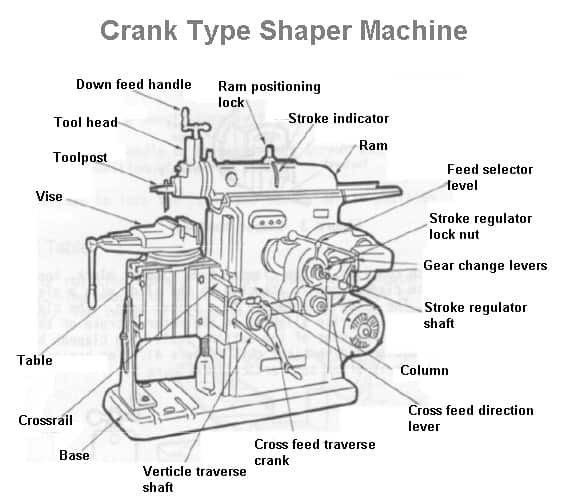
In construction, the crank shaper employs a crank mechanism to change the circular motion of a large gear called “bull gear” incorporated in the machine to the reciprocation motion of the ram.
It uses a crank mechanism to convert the circular motion of the bull gear into the reciprocating motion of the ram. The ram carries a tool head at its end & provides the cutting action.
#2 Gear Type Shaper Machine
In
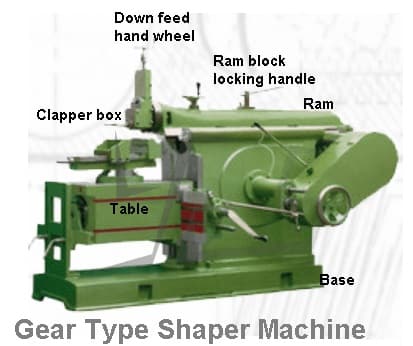
The speed and the direction in which the machine will traverse depend on the number of gears in the gear train. This type of shaper machine is not widely using in any industry.
#3 Hydraulic Shaper Machine
In
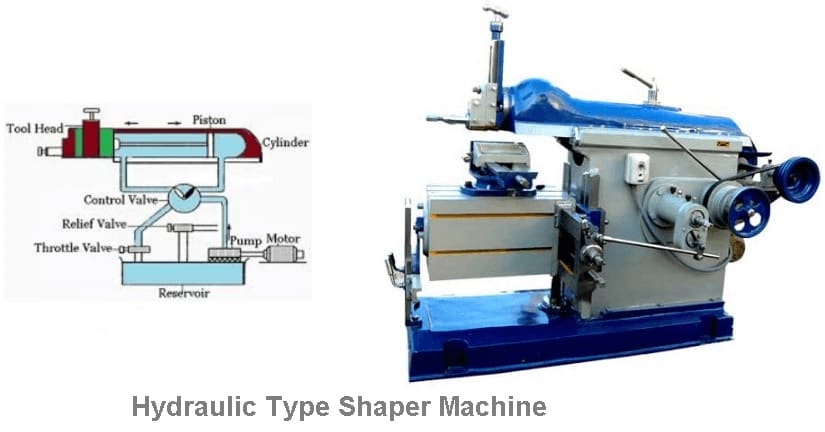
The high-pressure oil first acts on one side of the piston and then on the other causing the piston to reciprocating and the motion is transmitted to the ram. The main advantages of this type of shaper machine are that the cutting speed and force of the ram drive are constant. From start to end of the cut without making noise and operates quietly.
You might like: Understand The Essential Workshop Tools & Their Uses
B) Based on Ram Travel
Following are the different types of shaper machines based on ram travel.
#4 Horizontal Shaper Machine
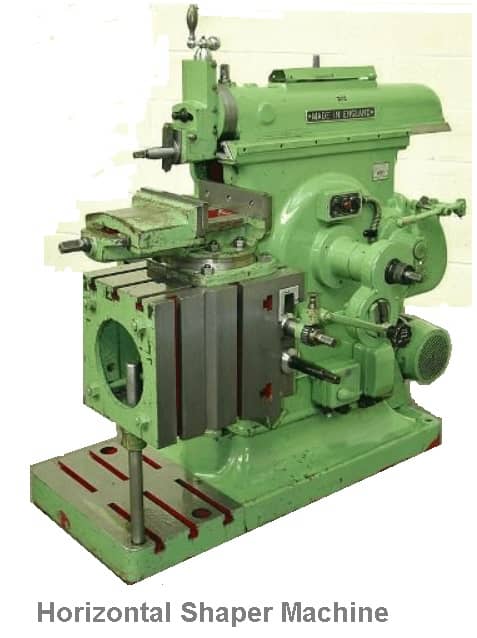
In these types of shaper machines, the ram is reciprocating. The ram holding the tool on a horizontal axis and reciprocate. This type of shaper is using for the production of flat surfaces, external grooves, keyways, etc.
#5 Vertical Shaper Machine
In these types of shaper machines, the ram reciprocating in the verticle plane. In this, the table holds the workpiece. Verticle shapers maybe crank driven, rack-driven, screw-driven, or hydraulic power-driven.
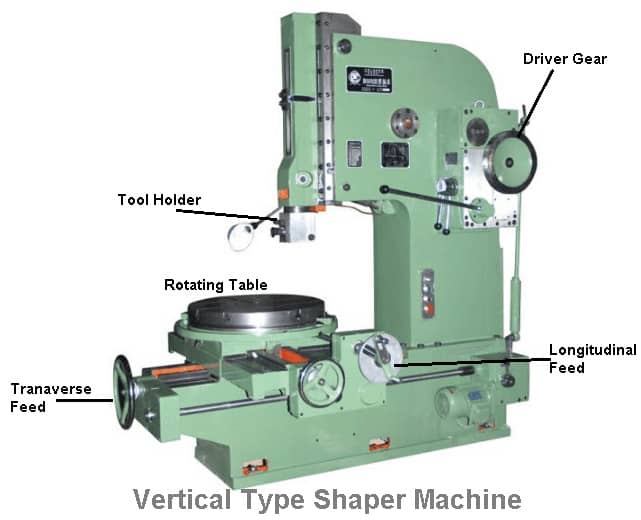
The vertical shaper is very convenient for machining internal surfaces, keyways, slots, or grooves. The workpiece can move in any given direction such as the cross, longitudinal or rotary movements. This type of shaper is suitable for machining internal surfaces, slots & keyways.
You might like: What is Gear Cutting? Types, [with Pros and Cons]
C) Based on The Table Design
Following are the different types of shaper machines based on the table design.
#6 Standard Shaper Machine
In this type of shaper machine, the table has only two movements, vertical and horizontal, to give the feed. That’s why it is known as a standard shaper machine. Here the table is not supporting at the outer end.
#7 Universal Shaper Machine
In these types of shaper machines, in addition to the two moments i.e. vertical and horizontal, the table can be moving on an inclined axis, and also it can swivel on its own axis.
Since the workpiece mounted on the can be adjusted in different planes, the shaper is suitable for a different type of operations and is given the name “Universal”. This type of shaper is commonly using the tool room works.
D) Based on Cutting Stroke
Following are the different types of shaper machines based on cutting stroke.
#8 Push cut Shaper Machine
In these types of shaper machines, the metal is removed in the forward motion of the ram. These are commonly used types of shaper machines.
#9 Draw cut Shaper Machine
In these types of shaper machines, the metal is removed in the backward motion of the ram. In this shaper, the tool is fixed in the tool head in the reverse direction so that it provides the cutting action in the reverse stroke of the ram.
You might like: What are Different Types of Chips In Metal Cutting?
Advantages of Shaper Machine
Following are the advantages of shaper machine:
- The cost of the shaper machine’s single point cutting tool is low.
- In this machine, the workpiece can be held conveniently.
- Using a shaper machine, flat or angular surfaces are easily produced.
- The Shaper is very simple to set up, and switching out the tools is also simple.
Disadvantages of Shaper Machine
The disadvantages of Shaper Machine include the following:
- Cutting speed is not particularly high.
- You can fix just one cutting tool. More than one cutting tool is not an option.
Application of Shaper Machine
Following are the applications of shaper machines:
- To produce the straight and flat surfaces on the workpiece.
- To smooth the rough surfaces.
- It is used to create an internal partition or splines.
- Used in making of gear teeth.
- Shaper is used to make dovetail slides.
- To produce keyways in pulleys or gears.
Difference Between Shaper and Planer
| Shaper Machine | Planer Machine |
|---|---|
| In a shaper machine, the work is kept constant, and the cutting tool on the RAM is moved back and forth during the work. | In the planer machine, the equipment is stationary, and the workpiece travels back and forth under the tool. |
| A shaper is traditionally a small machine and is preferred for small jobs. | A planner is a large machine and can have heavy and large jobs. |
| A shaper light may employ cut and fine feed. | The planer can employ heavy cuts and rough feeds. |
| This machine uses one cutting tool at a time. | This machine uses different tools for cutting simultaneously. |
That’s it. Thanks for reading. If you have any questions about shaper machines and types of shaper machines please leave a comment and I’ll respond.
Download the PDF of this article
Here are some articles you might like to read:
- Drilling Machine [Breifly Explained]
- 15 Different Types of Milling Machines
- Types of Lathe machines
- What Are The Different Types Of CNC Machine?
- What is Jig Boring Machine? Different Types Explained
- 14 Types of Grinding Machines [Complete Guide]
- Difference Between Up Milling and Down Milling [PDF]
- What is DNC Machine? Functions, Types, Parts, Advantages
- Understand The Working Principle of NC Machine
External Links:
Frequently Asked Questions
Compared to other machining methods, shaper machines are typically more affordable and call for less complicated tooling. Additionally, it can produce many different shapes and profiles, such as internal and external surfaces, keyways, slots, and dovetails, offering versatility in machining applications.
Steel, cast iron, aluminium, brass, and bronze are just a few of the metals that a shaper machine can typically work with. It can also be used with non-metallic substances like composites and plastics. Depending on the capabilities and cutting tools offered by the specific shaper machine, the compatibility of the particular material may change.
Construction and manufacturing industries both use shaper machines often. Also, they are used to create internal splines. It is also known that these machines are suitable for making dovetail sliders.
In a shaper machine, cutting speed is determined by the material and spindle speeds, while feed rate is determined by stroke length and surface finish requirements. Variables like tooling considerations, machine rigidity, and particular machining requirements are taken into account when making adjustments.
The main functions of a shaper machine are external machining operations, which include producing flat surfaces, keyways, slots, and other external profiles. Although some shaper machines might have attachments or accessories to help with internal machining, like internal keyways, the primary focus is on external machining.
Thank you sir
You’re welcome 🙂
Helps a lot…
Thanks 🙂
Thank you providing easy step about mechanical base
You’re welcome
Thank you very muchyour help
You’re welcome 🙂
Thanks for providing information in easiest language
You’re welcome 🙂
Great article
Thanks for sharing this great information in shapping machine
You’re Welcome